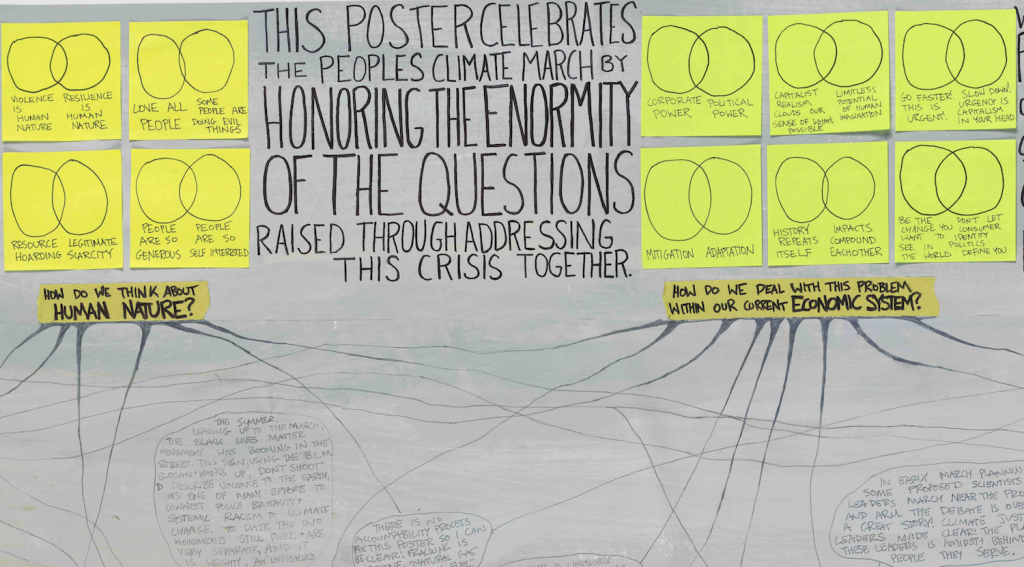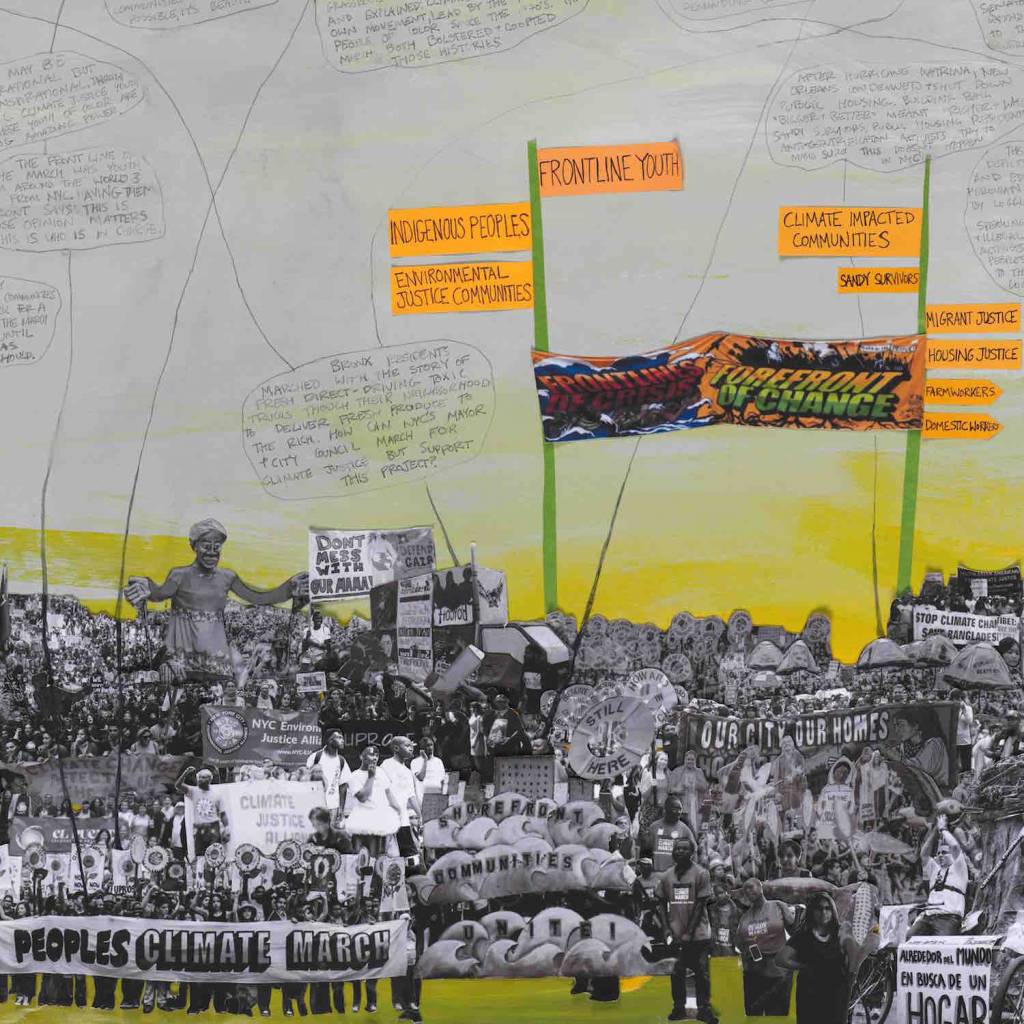I was deeply impressed by the creativity and leadership of Rachel Schragis during the People’s Climate March. Her latest artistic project seeks to visualize that momentous day, as well as help ignite new conversations. I talked with Rachel recently about what this new tool can do for the climate movement.
LAUNCH Video: Confronting the Climate: A Flowchart of the People’s Climate March from Rachel Schragis on Vimeo.
Rachel: My name is Rachel Schragis. I am an artist and a cultural organizer, which means that I work between things that we call organizing and things that we call art to make creative organizing happen and I was born and raised in New York City and I live here now.
Thelma: You have an exciting new art project that you’re releasing. Could you give me a background on what was the inspiration and what were the moments that led you to work on this current project?
R: So this project is the coming together of two different stories in my life. One was that this project was directly inspired by my experience coordinating the arts team for the People’s Climate March. I was inspired by how much I learned through that experience and how many different threads of struggle around what it means to confront climate change I got to witness by helping people come up with visual solutions for how to communicate those struggles. And I want to share some of that experience. Besides that, I’ve done a number of other big complicated mapping projects that try to connect feelings to fact and different kind of facts to each other to provide big rich infographics that give people the opportunity to dig deep into the details of the complex issues of our time. This project is my first attempt to do that in a way that centers the fact that no information is neutral and every story is told by some person who is living it, so it uses images of other people and stories collected from other people to map this big complicated struggle against climate change in the moment of the People’s Climate March.

T: This art piece helps show the big questions about conflicting truths in the climate movement. Can you talk more about that? What did you find was the biggest threads that you wanted to pull out and visualize?
R: So the first thread, the first idea that lead me to using these venn diagrams were the statements that it’s too late to do anything about climate change, and it’s not too late to do anything about climate change, which are opposites but they are both totally true. That inspired me to think about what are the other moments in which all we can do is acknowledge that the opposites are both true and that the truths contradicts itself. The first sets of contradictions that I was motivated to dig into with this project were about how we talk about everyone, how we talk about all of humanity when every opinion counts and also recognizing people’s experiences are different from each other in a society that structures itself in hierarchical oppressive ways. So every opinion counts and yet some people’s life experiences means that they have wisdom and they need to be in the front of this fight because they’re the most directly impacted — or everyone is human and we are here to save everyone but some people are the humans that are causing this problem and they are not on our team, they are the enemy. How do you navigate all of that, and have empathy for people and also treat people in a differentiated way based on the fact that some of us are leaders in this fight and some of us are not on the team of justice at all?

T: So with this art piece that you have, how do you hope it could be used by different organizations and movements and what are the conversations you want to come out of the people using this piece?
R: Like a lot of art work this image is meant to be connective tissue, so it’s kind of meant to do a bunch of things at once. One thing is that it captures the enormity of the People’s Climate March. It’s meant to be a tool that helps you talk about the march if you were there or if you weren’t there and think if it was an interesting or important moment. Or it is a visual example of the fact that tons of people from all walks of life care about climate change — it’s just meant to show that to help make it real. It’s also really designed to be used by people who aren’t currently talking about climate change because in each of the different segments both at the top where there’s questions and in the big orange banners it talks about how other different kinds of struggles are leading people to mobilize about climate change. So it’s meant to be an image you can see yourself in, you can use in a classroom, you can use in a community group that’s mostly not talking about climate change to say where do we fit in this conversation about the climate. Lastly I would say it’s meant to agitate and a way for us to think forward about the next steps of the climate movement by lifting up all the things we haven’t solved yet. The bottom of the image sorts people by how they’re identifying themselves and at the top it re-sorts all the same information into who is asking what questions. The questions are how do we deal with climate change issues in our current economic system, how do we think about how climate change makes us feel, how do we think about the role of nature and non-human life on climate change and to suggest that we could break this off into some big questions that we need to tackle as another way to think about doing our work.

T: How do you think the Climate Movement can be able to achieve really important goals and hold complexity and conflicting truths at the same time?
R: I think that there’s a lot to learn in the layout of the People’s Climate March, which is part of why I picked this moment as one to lift up. It was a moment where we were reckoning in the U.S. context — reckoning with the illogical world of identity politics, the complex world of the many many ways people identify themselves and how random that can seem. If you look at the little flags on the map, these are the different categories that people mapped themselves into. Many people would fit into many categories. People are a mom and a Hurricane Haiyan survivor, and a fan of sustainable energy, and they’re from New Jersey, and that could mean they could be in four different places. I’m saying to say that there is not going to be one way in which we ask everyone to be part of the climate movement, a lot of people in the climate movement don’t identify as such, a lot of people in the march don’t identify as such, there were people who cared about the world and showed up for one day. There were people who cared about something else and they showed up to stand in solidarity that day. And I think we have to be flexible and open minded to the ways that showing up to do the work looks in lots of different people’s lives and celebrate those of us who say I am in this because I am concerned about the carbon parts per million in the atmosphere, and not consider that in conflict with people who are saying I am going to show up to a climate march for one day because I understand that climate justice is racial justice and that’s what motivates me to do this work, you know- we’re on the same team.
You can donate to Rachel’s Kickstarter to fund this project and get it out into the world for people to use.